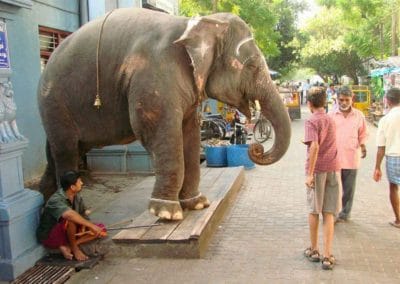Threats to Elephants
ELEPHANTS IN CAPTIVITY
Every elephant deserves to roam free
Humans have been capturing and exploiting elephants for over 4,000 years. Today, there are an estimated 15,000–20,000 elephants in captivity around the world. More docile and trainable than their African cousins, the majority of captive elephants not found in zoos are Asian elephants.
Almost one-third of the world’s Asian elephants live in captivity. Historically, they were used in logging and agriculture, but are now increasingly being exploited for tourism. Asian elephants are forced to entertain humans in circuses, carnivals, traveling shows, tourist attractions, trekking camps, etc. These elephants are stolen from their families and broken into submission—all in the name of entertainment.
Elephants are broken into submission for captivity through a brutal process, called the Phajaan. Elephants that survive this unspeakable physical and emotional pain are often called domesticated, but that is a false and misleading term. They are forcibly and violently tamed by humans, who reinforce their dominance through the use of bull hooks (also known as “elephant goads”) and other measures. Their captivity often comes in a variety of painful forms including:
- Use in entertainment industries (circuses, traveling shows, carnivals, fairs, films, marketing campaigns—and as curiosities to promote businesses)
- Use in agricultural and logging industries
- Use as sight-seeing transport in trekking camps and for elephant-back-rides
- Use as “Temple Guardians,” where they are chained near temples to encourage donations from visitors and passersby

The Brutal Phajaan “Training”
Baby elephants as young as three-years old are stolen from their mothers in the wild and dragged to a clearing to endure the Phajaan or “breaking of the spirit.” They will be kept in small crates (called “crush cages”) where their legs are bound and stretched with ropes. They will be stabbed, beaten, burned, starved of food and water, and subjected to constant yelling and screaming. Bull hooks are used to stab their heads, slash their skin, and tug their ears. Asian elephants used for rides or other entertainment often have torn or shredded ears from being ripped during the Phajaan. They also often have scars on their foreheads from deep lacerations caused by beatings.
The Phajaan may last from several days to weeks. The elephants have no rest from mental and physical torture. Gradually, their spirits are broken. In the final stage, the mahout will bring the animal its first food and water. They will be the one to release the elephant and lead it away from the crate. After weeks of torture, emotional abuse, loneliness, confusion, and separation, the elephant sees this human as its savior—the one it trusts. This is just another stage of mental and emotional manipulation. It is how a mahout gains control over such an immense animal.
Elephants in Captivity in the US
There are an estimated 400 elephants in captivity in the United States, primarily in zoos (300+), circuses, and traveling shows. (This figure does not contain the number of elephants in unregulated facilities.) Elephants are enormously intelligent, social animals that form life-long bonds that do not diminish over time or with separation. Thus, elephants in the entertainment industry experience deep and long-lasting physical, emotional, and psychological harm from the loneliness, stress, neglect, and cruelty they undergo in captivity.
Few legal protections exist in the US for animals forced to perform in traveling shows. The federal Animal Welfare Act (AWA) provides standards for the treatment of warm-blooded animals traveling with circuses, but the standards are minimal and frequently violated. Circus elephants can spend up to 11 months of the year traveling thousands of miles chained inside vehicles that often lack climate control, typically standing in their own waste.
The tricks elephants are forced to perform are unnatural and dangerous. In the coercive training used to control elephants in their “care,” handlers resort to hitting, prodding, and striking them with bull hooks. When not entertaining, elephants are usually chained alone, depriving them of the companionship that they desperately crave. This painful isolation and suffering is well documented and can cause further self harm from their repetitive swaying, rocking, or head bobbing while chained.
TROPHY HUNTING
Trophy hunting is deliberately cruel to animals and corruptly indifferent to local communities and conservation. Hunters defend their morally unethical “sport” with claims that hunting fees help local economies and fund conservation efforts. But research shows these fees cannot compete with other tourist revenue opportunities. And due to corruption and government indifference, much of the hunting industry money never makes it into local economies. A 2006 Biological Conservation study estimated that hunting trips in sub-Saharan Africa generated annual revenue of around US $201 million. Meanwhile, a World Bank study estimates that tourists to that region in 2012 generated US $36 billion.
A 2006 Biological Conservation study estimated that hunting trips in sub-Saharan Africa generated annual revenue of around US$201 Million. Meanwhile, a World Bank study estimates that tourists to that region in 2012 generated US$36 Billion.
A recent Humane Society International report found that in eight African countries that permit trophy hunting, it amounted to less than 2% of total tourism revenue. People in Botswana viewed photographic camps as more beneficial to the economy than hunting because they employed more people year-round. Claims that trophy hunting helps cull and conserve species are exaggerated. According to Born Free USA, trophy species—elephants, rhinoceroses, giraffes, lions, etc.—are in serious decline in countries that allow them to be hunted. And by targeting the biggest and strongest in the herds, trophy hunting dramatically lessens the gene pool and survival rates of these amazing animals.
Trophy hunting is advertised as “sport” yet is anything but that. Elephants do not anticipate being shot and so don’t run away from hunting groups. Trophy hunters can easily move into advantageous positions to shoot these magnificent animals. The first shot is often not fatal. Once wounded, these now defenseless elephants endure immense suffering. Terrified and trying desperately to flee, they must endure a prolonged attack and a slow agonizing death. Many animals — including rhinoceroses, giraffes, and baboons — suffer similar fates. During “canned” hunts, lions bred in captivity are released into enclosed areas from which they can’t escape being shot at point-blank range by “hunters.” There is no skill involved and the animals have no chance of escape.
Note: Trophy hunters often kill simply because they can. Well-known trophy hunter Ron Thomson claims to have killed more than 5,000 elephants. He proudly recalls a time using military semi automatic rifles, “… three of us were able to kill between 30 and 50 elephants stone dead with brain shots in less than 60 seconds. We did it exceptionally well.” His full and disturbing account was posted by Animal Welfare Watch and shared to the Animal Rights Strategy Group (Original) Facebook page on 09/12/20.
TROPHY HUNTING STATISTICS
- From 2004 and 2014, an estimated 200,000 hunting trophies of threatened species were traded between nations, an average of 20,0000 trophies per year.
- The United States accounts for 71% of the trophy import demand, that’s 15 times more than the next highest nations, Germany and Spain (both 5 percent).
- The Top 20 countries account for 91% of all imported trophies.
- The “Africa Big Five”— African elephants, rhinoceroses, lions, leopards, and the African buffalo—are amongst the most prized and sought after trophies.
- About 8,500 trophy hunters visit South Africa each year, compared to around 9.5 million tourists.
CALIFORNIA LEGISLATION AND GOV. NEWSOM
California bill, SB 1175, would prohibit the importation and possession of animal parts from a list of endangered and threatened African species, including elephants, lions and rhinos. Hunting advocates and groups oppose this bill that would greatly reduce the cruelty of trophy hunting.
The bill would deter hunters like Aaron Raby of Los Angeles. Raby paid more than $30,000 to travel to South Africa in December 2019 to kill a defenseless young elephant, and an additional $10,000 to have its head preserved as a souvenir. Hours after killing the elephant, Raby said that he had a piece of it for dinner, with a side of tomato and avocado.
“I don’t understand why this is anybody’s business but my own,” Raby told the Los Angeles Times. “What I did was legal. I didn’t break a law. They’re going to place a ban because a bunch of … crybabies that don’t like hunting.”
Contact your local California representative, senator, and Gov. Newsom’s office to insure the passage of this important legislation.
- From 2004 and 2014, an estimated 200,000 hunting trophies of threatened species were traded between nations, an average of 20,0000 trophies per year
- The United States accounts for 71% of the trophy import demand, that’s 15 times more than the next highest nations, Germany and Spain (both 5 percent).
- The Top 20 countries account for 91% of all imported trophies
- The “Africa Big Five”— African elephants, rhinoceroses, lions, leopards, and the African buffalo—are amongst the most prized and soughtaftertrophies
- About 8,500 trophy hunters visit South Africa each year, compared to around 9.5 million tourists.
- A 2006 Biological Conservation study estimated “a minimum of 18,500” hunters participate annually in hunts in sub-Saharan Africa and generate revenue of around US$201 million
- A World Bank study estimates around 33.8 million tourists visited sub-Saharan Africa in 2012 and earned the region US$36 Billion.
LINKS
- International Fund for Animal Welfare (IFAW) report on trophy hunting
https://d1jyxxz9imt9yb.cloudfront.net/resource/36/attachment/regular/Killing_For_Trophies.pdf - Humane Society International report
https://www.hsi.org/wp-content/uploads/assets/pdfs/economists-at-large-trophy-hunting.pdf - The economics of trophy hunting
https://africacheck.org/factsheets/factsheet-how-much-does-hunting-contribute-to-african-economies/ - ‘conservation benefits’ can really justify trophy hunting
https://phys.org/news/2019-10-trophy-benefits.html - What Trophy Hunting Does to the Elephants It Leaves Behind
https://www.theatlantic.com/science/archive/2017/11/elephant-trophy-hunting-psychology-emotions/546293/ - Animal Rights Strategy Group, RE; Ron Thomson
https://www.facebook.com/groups/321110578261972/permalink/1156708444702177/ - Horrific video shows California trophy hunter (Aaron Raby) kill a helpless young elephant then pose with its corpse
https://www.the-sun.com/news/1251666/horror-video-show-moment-hunter-kills-young-elephant/ - No place for trophy hunting in the sixth extinction
https://africanelephantjournal.com/no-place-for-trophy-hunting-in-the-sixth-extinction/

Massachusetts: Say No to Ivory and Rhino Horn Trafficking
Please take action by asking legislators to support passage of these important protections for elephants here in the Commonwealth:
Petition your State Senator and your State Representative to enact Senate Bill S.519.
The objectives of these bills are to:
- Prohibit the ivory and rhino horn trade in Massachusetts.
- Prevent ivory traffickers from exploiting Federal loopholes and the mixing of illegal ivory with legal sales.
The purpose of these bills is not to:
- Criminalize possession of ivory currently owned by Massachusetts residents or prohibit inheritance or noncommercial gifts.
Find out more about S.519, the ivory ban bill, by clicking on the link below:
Click Here
Find your state legislators here: Click Here!
Phone them both to let them know you support these bills - and follow up your action with quick written emails to both.
Massachusetts: Say No to Ivory and Rhino Horn Trafficking
Please take action by asking legislators to support passage of these important protections for elephants here in the Commonwealth:
Petition your State Senator and your State Representative to enact Senate Bill S.519.
The objectives of these bills are to:
- Prohibit the ivory and rhino horn trade in Massachusetts.
- Prevent ivory traffickers from exploiting Federal loopholes and the mixing of illegal ivory with legal sales.
The purpose of these bills is not to:
- Criminalize possession of ivory currently owned by Massachusetts residents or prohibit inheritance or noncommercial gifts.
Find out more about S.519, the ivory ban bill, by clicking on the link below:









